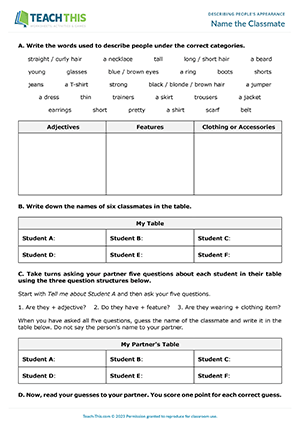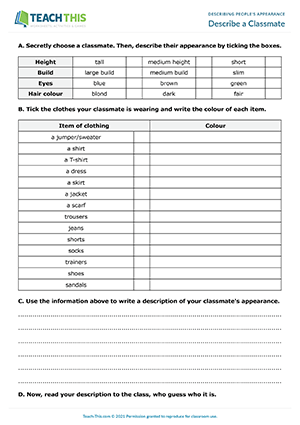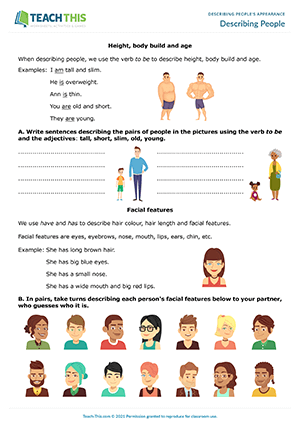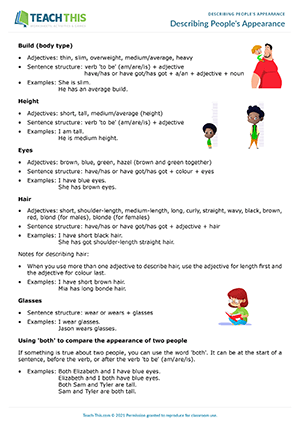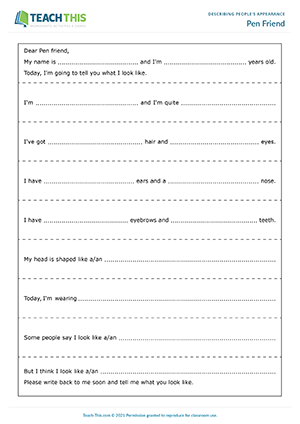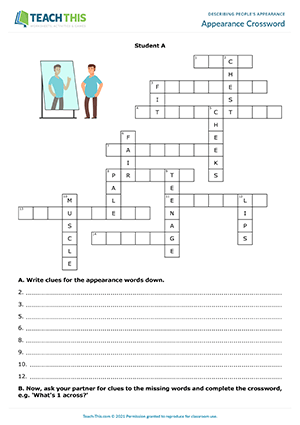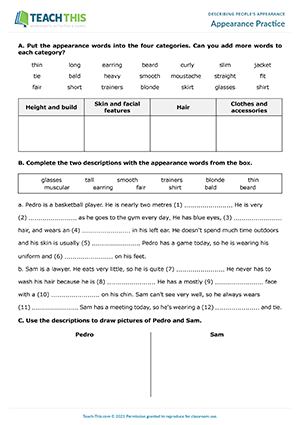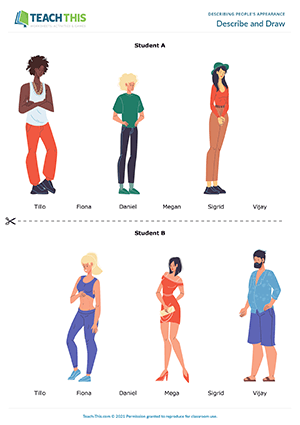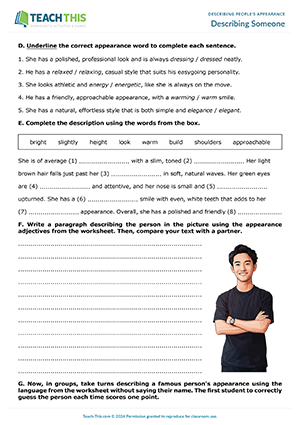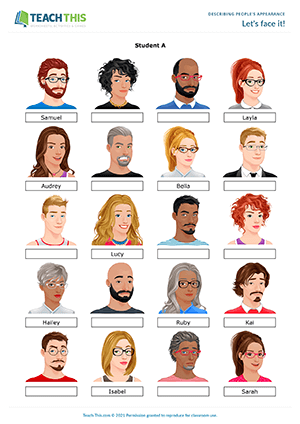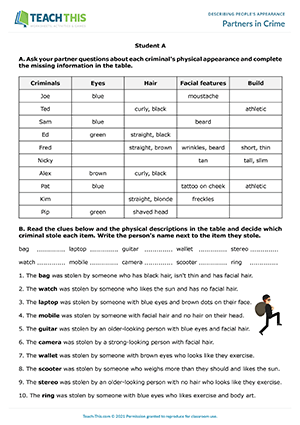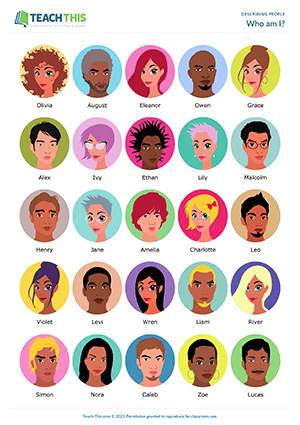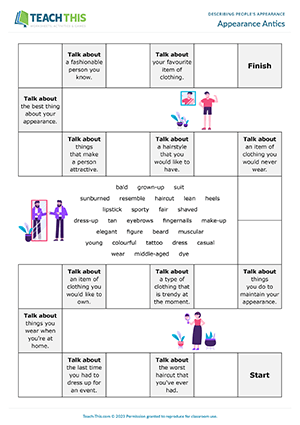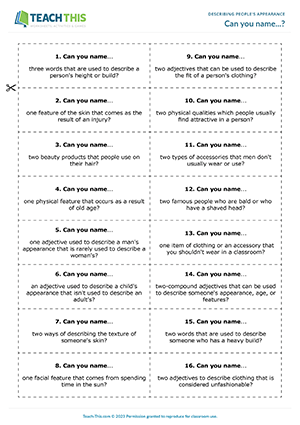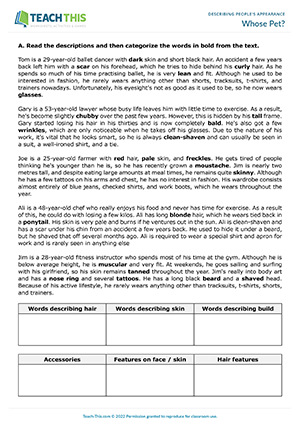In this engaging describing people game, students ask questions about people's appearance in order to guess the names of six classmates a partner has written down. First, working alone, students categorise vocabulary used to describe people into adjectives, features and clothing or accessories. Students then write the names of six classmates in a table. Next, students pair up with another student and take turns asking their partner five questions about each student they wrote down using three question structures: Are they + adjective? Do they have + feature? Are they wearing + clothing item? When a student has asked all five questions, they guess the name of the classmate and write it in a table, without telling their partner. When the students have both written their six guesses, they check their answers with their partner. Students score one point for each correct guess. The student with the most points wins the game.
In this handy describing appearance activity, students describe a classmate's appearance and the class tries to guess who it is. Students secretly choose a classmate to describe. Students then tick the boxes on the worksheet that describe the classmate's height, build, eye colour, hair and clothes. Next, students use the information on the worksheet to write a description of their classmate's appearance. When the students have finished, they take it in turns to read their descriptions to the class who guess which student is being described.
This free describing appearance lesson helps to teach students how to describe people's appearance and clothing. Students begin by learning how to use the verb to be to describe height, body build and age. Students then practice the language by writing descriptions of people. After that, students learn how to use have and has to describe hair colour, hair length and facial features. Students then describe people from the worksheet using have and has. Next, students learn how to describe what someone is wearing and then they write about what they are wearing now and what they wore yesterday. Students then describe pictures of two people and complete gap-fill exercises to consolidate the language from the lesson. Students then move on to describe themselves and a secret classmate. Next, students read their descriptions aloud and the class tries to guess who is being described. Finally, students read descriptions and draw pictures of three thieves.
This useful describing appearance worksheet can be used to help students practice describing someone's build, height, hair and eyes. Students also practice writing sentences with both to talk about two people's similar appearance. Students start by reading how to describe people's appearance and using the information to identify and correct mistakes in sentences describing students. Next, students match descriptions to people. In the last exercise, students write sentences using both to describe one thing that is true for two people's appearance.
In this creative describing people activity, students invent a person and write a letter to a pen friend as that person, describing their height, weight, facial features, clothing and general appearance. First, students invent a name and age for the person writing the letter. Students then complete the first sentence with the information, fold the letter so that the sentence is hidden, and pass it to the person on their right. After that, students invent the next piece of information about the person's appearance and complete the second sentence, folding and passing the paper as before. This process is repeated until all the sentences have been completed. When the students have finished, they unfold their letter and read it aloud to the group. This is their new pen friend! The letters should make an entertaining read. Students can then use the same worksheet to write a reply to their new pen friend.
In this enjoyable appearance adjectives activity, students describe and guess words and adjectives related to physical appearance. In two groups, students invent and write down clues for the physical appearance words written on their crossword. Students then pair up with someone from the other group and take it in turns to ask their partner for a clue to one of their missing words. Their partner reads out the clue for that word and the other student tries to guess what it is. If the student guesses the word successfully, they write it on their crossword. If not, their partner continues to give more clues until the student is able to guess the word. Lastly, students check their spelling by comparing crosswords.
In this comprehensive describing people worksheet, students learn vocabulary for describing appearance and practice describing and drawing people. First, students put appearance words into four categories and see if they can add more words to each category. Next, students complete descriptions of two people using words from the first exercise and then draw pictures of them. Students then write sentences about their own appearance using the four categories. Students then move on to put words in the correct order to form questions, asking about someone's appearance. Lastly, students draw a picture of a person and then ask a partner about the person they have drawn using the questions. Students then draw the person from their partner's answers and compare drawings.
Here is an engaging describing people speaking activity to help students practice describing people's physical appearance, clothing and body posture. In pairs, students take it in turns to describe people on their worksheet to their partner who listens carefully and draws the people. Afterwards, students compare pictures to check they have drawn the people correctly.
In this productive describing people worksheet, students practice adjectives for describing someone's appearance, personality and character. To start, students write adjectives to describe someone's physical appearance, according to certain categories, e.g. height, build, etc. They do this by looking up adjectives they already know in a dictionary and writing down any new synonyms or antonyms they find. For example, if the category was build, students might look up the adjective slim and write down the synonym slender. Students then look up ten adjectives to describe someone's personality and character in a dictionary and write down synonyms or antonyms of the adjectives on the worksheet. Next, students match sentence halves together that describe physical appearance. After that, students use adjectives from Exercise B to complete sentences that describe personality and character. Finally, students think of someone they know well and write a paragraph describing them. Students write about the person's appearance, personality and character using the adjectives from the worksheet.
In this free describing appearance speaking activity, students match names to faces by giving and listening to descriptions of people's facial features and hair. In pairs, students take it in turns to name and describe the people on their worksheet for their partner to identify, talking about the person's facial features, hair colour, hair type, hairstyle, facial hair and age. Their partner's task is to listen carefully and identify the person on their worksheet, labelling the picture with the correct name. Their partner then checks they have the correct person by asking questions, e.g. 'Does Samuel have wavy hair?' Afterwards, students compare their worksheets to check their answers.
In this fun describing appearance speaking activity, students ask questions about people's physical appearance in order to solve a crime puzzle. In pairs, students take it in turns to ask their partner questions about various people's appearance in order to complete the missing information about the criminals in their chart. When the students have completed their charts, they read the crime clues and physical descriptions in the chart and decide which criminal stole each item, writing the name of the person next to the item that they stole.
In this entertaining describing appearance game, students ask yes/no questions about appearance in order to find out their secret identity. In pairs, one student picks a person at random from the character sheet and writes the character's name on a piece of paper, keeping it hidden from their partner. Their partner then has to find out who they are by asking yes/no questions, e.g. 'Am I a woman?' 'Do I have long hair?' Etc. The other student replies yes or no accordingly. Each time the student asks a question, they score one point. When the student thinks they know who they are, they ask a yes/no question using the character's name, e.g. 'Am I Olivia?' Students continue taking it in turns to play until they have been five characters. The student with the least amount of points at the end of the game wins.
Here is an enjoyable appearance vocabulary board game to help students practice describing how people look. In groups, students take turns picking up a card and reading the sentence to the other students using the word 'blank' for the missing word, e.g. 'Maya is very BLANK. She looks good in everything she wears.' The other students listen to the sentence and race to choose a word from the game board and say it aloud to complete the sentence, e.g. elegant. The first student to say the correct word rolls the dice and moves their counter along the board. If a student lands on a 'Talk about' square, they talk about that topic for 20 seconds to remain on the square. If they are unsuccessful, they move back one space. The first student to reach the finish wins the game. As a variation, students take turns trying to complete a sentence with a word from the board rather than racing each other.
In this imaginative describing appearance game, teams race to come up with words used to describe appearance based on prompts. In two teams, students take turns picking up a card, reading out the prompt, and placing the card face-up on the table. The two teams then race to come up with appearance vocabulary that matches the prompt. The first student to raise their hand and provide the appropriate vocabulary wins and keeps the card. If a student gives their answer without putting up their hand, the other team gets to keep the card. The team with the most cards at the end of the game wins. Afterwards, review the students' answers together as a class.
This interesting describing people activity helps students practice vocabulary used to describe people's appearance. Students begin by reading descriptions of five people. Students then put words in bold from the descriptions in their correct categories. Next, in pairs, students take it in turns to ask their partner for clues about who owns which pet, writing down the clues on their worksheet. When both students have a complete set of clues, they scan the descriptions and cross out the people that each clue eliminates based on their appearance. Once students have eliminated who does not own each pet, they write the animal below its owner's name.
Latest Free
Resources
- Everyday Objects Bingo
Everyday Objects
Elementary (A1-A2)
- Action Verb Races
Actions
Elementary (A1-A2)
- Birthday Basics
Birthdays
Elementary (A1-A2)
- Sales Phrasal Verbs
Business Phrasal Verbs
Upper-intermediate (B2)
Latest Member
Resources
- Collocations at Work
Business Collocations
Intermediate (B1)
- Etiquette Trivia Board Game
Etiquette and Manners
Upper-intermediate (B2)
- Everyday Objects Vocabulary
Everyday Objects
Pre-intermediate (A2)
- Let's have a talk
Verb-Noun Collocations
Pre-intermediate (A2)



